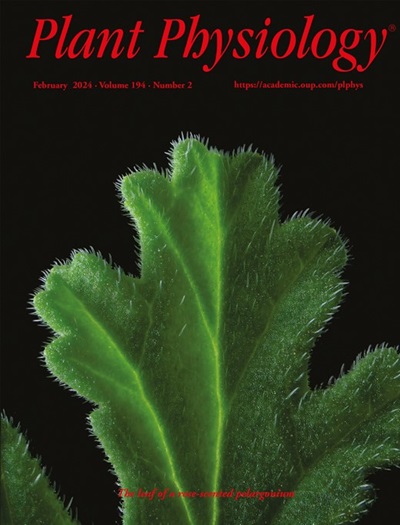Shoring up the base: the development and regulation of cortical sclerenchyma in grass nodal roots
IF 6.5
1区 生物学
Q1 PLANT SCIENCES
引用次数: 0
Abstract
Plants depend on the combined action of a shoot-root-soil system to maintain their anchorage to the soil. Mechanical failure of any component of this system results in lodging, a permanent and irreversible inability to maintain vertical orientation. Models of anchorage in grass crops identify the compressive strength of roots near the soil surface as the key determinant of resistance to lodging. Indeed, studies of disparate grasses report a ring of thickened sclerenchyma cells surrounding the root cortex, present only at the base of nodal roots. Here, in the investigation of the development and regulation of this agronomically important trait, we used the model species Brachypodium distachyon and show that development of these cells is uncoupled from the maturation of other secondary cell wall-fortified cells and that cortical sclerenchyma wall thickening is stimulated by mechanical forces transduced from the shoot to the root. We also show that exogenous application of gibberellic acid stimulates thickening of lignified cell types in the root, including cortical sclerenchyma, but is not sufficient to establish sclerenchyma identity in cortex cells. Leveraging the ability to manipulate cortex development via mechanical stimulus, we show that cortical sclerenchyma development alters root mechanical properties and improves resistance to lodging. We describe transcriptome changes associated with cortical sclerenchyma development under both ambient and mechanically stimulated conditions and identify SECONDARY WALL NAC7 as a putative regulator of mechanically responsive cortex cell wall development at the root base. Overall, our findings show that grasses use a coordinated system involving mechanoperception, phytohormone signaling, and transcriptional regulation to modulate investment in cortical sclerenchyma, proactively reinforcing anchorage in response to mechanical challenges.支撑基础:草节根皮层厚壁组织的发育与调控
植物依靠茎-根-土壤系统的共同作用来维持它们对土壤的锚定。该系统任何部件的机械故障都会导致倒伏,这是一种永久且不可逆转的无法保持垂直方向的情况。禾草作物锚固模型将根系靠近土壤表面的抗压强度确定为抗倒伏的关键决定因素。事实上,对不同种类的草的研究表明,根皮层周围有一圈增厚的厚壁组织细胞,这种细胞只存在于节根的基部。在研究这一重要农艺性状的发育和调控过程中,我们以模式种短柄草(Brachypodium distachyon)为研究对象,发现这些细胞的发育与其他次生细胞壁强化细胞的成熟是不耦合的,并且皮层厚壁组织的增厚是由茎部向根传导的机械力刺激的。我们还表明,外源应用赤霉素酸刺激根中木质素化细胞类型的增厚,包括皮质厚壁组织,但不足以建立皮层细胞的厚壁组织特性。利用机械刺激控制皮层发育的能力,我们发现皮层厚壁组织的发育改变了根的机械特性,提高了根的抗倒伏能力。我们描述了在环境和机械刺激条件下与皮层厚壁组织发育相关的转录组变化,并确定了次级壁NAC7是根基部机械反应性皮层细胞壁发育的假定调节剂。总的来说,我们的研究结果表明,禾本科植物使用一个包括机械感觉、植物激素信号和转录调节的协调系统来调节皮质厚壁组织的投资,主动加强锚定以应对机械挑战。
本文章由计算机程序翻译,如有差异,请以英文原文为准。
求助全文
约1分钟内获得全文
求助全文
来源期刊

Plant Physiology
生物-植物科学
CiteScore
12.20
自引率
5.40%
发文量
535
审稿时长
2.3 months
期刊介绍:
Plant Physiology® is a distinguished and highly respected journal with a rich history dating back to its establishment in 1926. It stands as a leading international publication in the field of plant biology, covering a comprehensive range of topics from the molecular and structural aspects of plant life to systems biology and ecophysiology. Recognized as the most highly cited journal in plant sciences, Plant Physiology® is a testament to its commitment to excellence and the dissemination of groundbreaking research.
As the official publication of the American Society of Plant Biologists, Plant Physiology® upholds rigorous peer-review standards, ensuring that the scientific community receives the highest quality research. The journal releases 12 issues annually, providing a steady stream of new findings and insights to its readership.
 求助内容:
求助内容: 应助结果提醒方式:
应助结果提醒方式:


